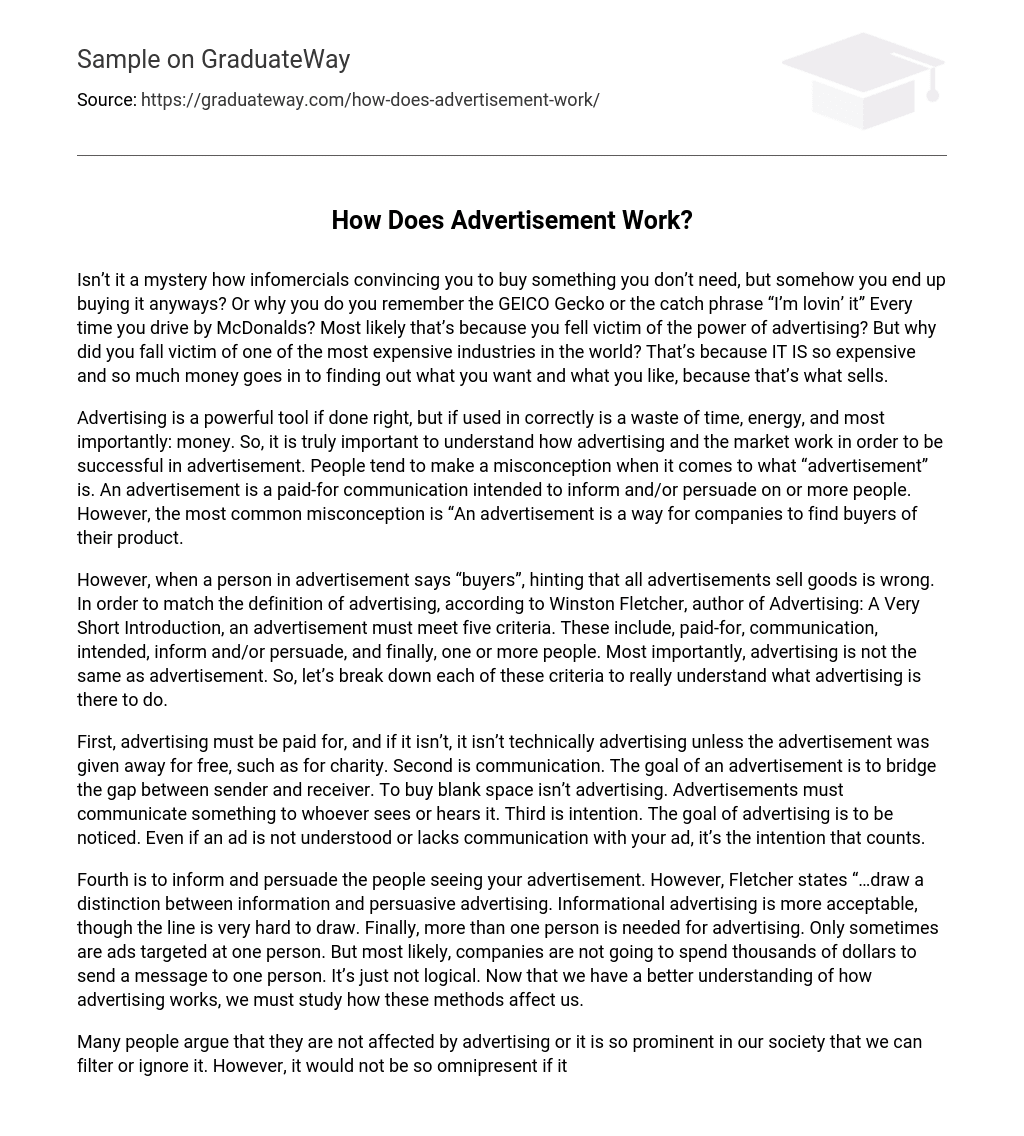Isn’t it a mystery how infomercials convincing you to buy something you don’t need, but somehow you end up buying it anyways? Or why you do you remember the GEICO Gecko or the catch phrase “I’m lovin’ it” Every time you drive by McDonalds? Most likely that’s because you fell victim of the power of advertising? But why did you fall victim of one of the most expensive industries in the world? That’s because IT IS so expensive and so much money goes in to finding out what you want and what you like, because that’s what sells.
Advertising is a powerful tool if done right, but if used in correctly is a waste of time, energy, and most importantly: money. So, it is truly important to understand how advertising and the market work in order to be successful in advertisement. People tend to make a misconception when it comes to what “advertisement” is. An advertisement is a paid-for communication intended to inform and/or persuade on or more people. However, the most common misconception is “An advertisement is a way for companies to find buyers of their product.
However, when a person in advertisement says “buyers”, hinting that all advertisements sell goods is wrong. In order to match the definition of advertising, according to Winston Fletcher, author of Advertising: A Very Short Introduction, an advertisement must meet five criteria. These include, paid-for, communication, intended, inform and/or persuade, and finally, one or more people. Most importantly, advertising is not the same as advertisement. So, let’s break down each of these criteria to really understand what advertising is there to do.
First, advertising must be paid for, and if it isn’t, it isn’t technically advertising unless the advertisement was given away for free, such as for charity. Second is communication. The goal of an advertisement is to bridge the gap between sender and receiver. To buy blank space isn’t advertising. Advertisements must communicate something to whoever sees or hears it. Third is intention. The goal of advertising is to be noticed. Even if an ad is not understood or lacks communication with your ad, it’s the intention that counts.
Fourth is to inform and persuade the people seeing your advertisement. However, Fletcher states “…draw a distinction between information and persuasive advertising. Informational advertising is more acceptable, though the line is very hard to draw. Finally, more than one person is needed for advertising. Only sometimes are ads targeted at one person. But most likely, companies are not going to spend thousands of dollars to send a message to one person. It’s just not logical. Now that we have a better understanding of how advertising works, we must study how these methods affect us.
Many people argue that they are not affected by advertising or it is so prominent in our society that we can filter or ignore it. However, it would not be so omnipresent if it didn’t work. Ewald Berkers, owner of the website Uneticed. com, speaks about how advertising affects the person through manipulation, but in a way you don’t even realize it. Berker’s explains, “Advertisers hide the manipulative parts of advertising, because people will not accept it if they notice being manipulated. It needs to appear innocent in order to have an influence. Advertising has influence, but it doesn’t come right out in say it. The best advertisements are the ones that leave you with something after seeing it.
The best advertisements according to The Atlantic Times Why Good Advertising Works (Even When You Think It Doesn’t) are the ones that “…create positive memories and feelings that influence our behavior over time to encourage us to buy something at a later date. No one likes to think that they are easily influenced. In fact, there is plenty of evidence to suggest that we respond negatively to naked attempts at persuasion. Therefore, advertisement is a mental game and target practice as advertisers try to find new and unique ways to catch a viewer or potential consumer’s attention. The investment in advertising is in market research, the reason why advertisements are both expensive, yet affective. The complete other side to good advertisement has to do with how effective you really are going to have on the people you’re trying to impress, your “target market”. There is definitely a reason why men’s shaving cream and truck ads aren’t on a kid’s network in the middle of the day and why cigarette ads are at eye-level of a majority of five-year olds.
This is known as targeting, and it’s harmless unless you allow yourself to become targeted. To explain it more simply, all targeting advertisements understand who they are targeting and how it will affect the person. Over 75% of the success of advertisement is leaned on the understanding of the audience and making it fit them. As you can see, advertising and advertisements are designed in such a way that they can have power and influence over an audience instantly, even before the person even realizes they have been “brainwashed” as some might say.
In honesty, because of how emotional and attached our advertisements have become with people and consumers, advertisement or propaganda is becoming more and more successful for launching business and extending company gains. Long story short, advertisement really is so successful because it is so finite and detailed that it is unique, which gives it all its power. If advertising were more broad and less planned out, it would not be nearly as powerful as it is now.





